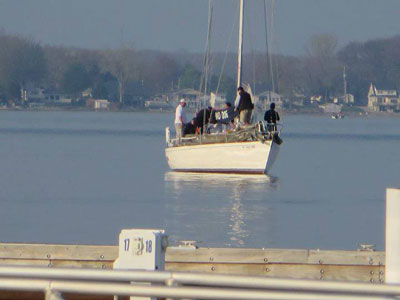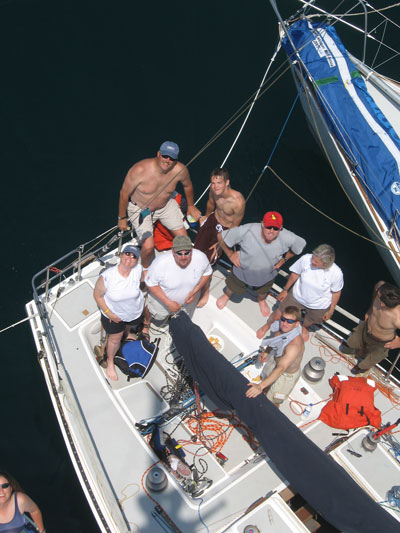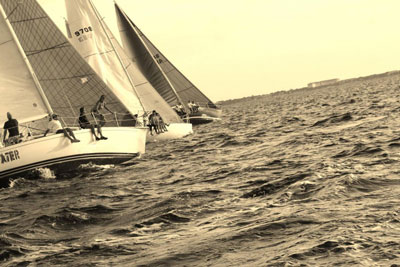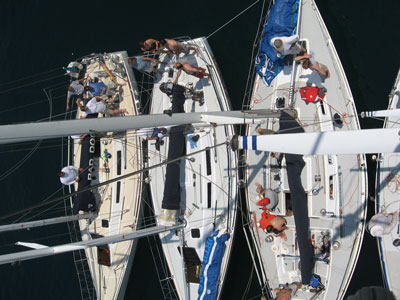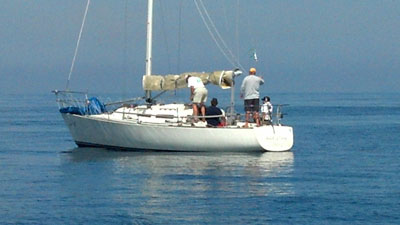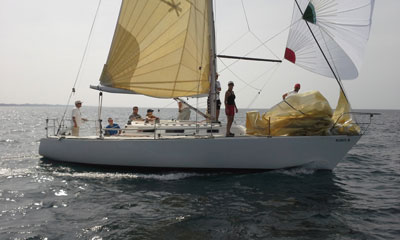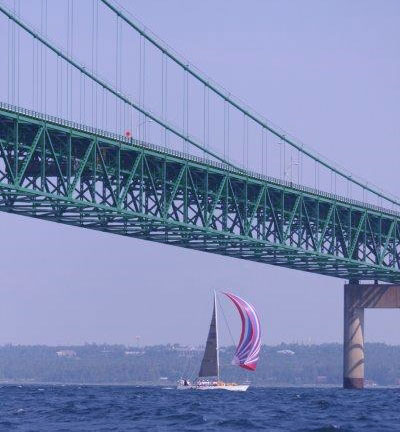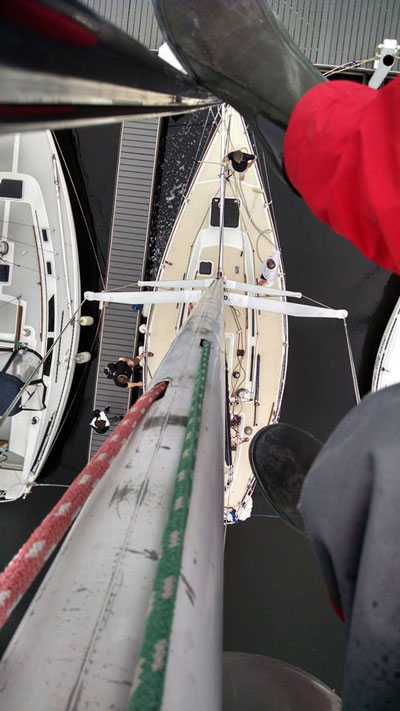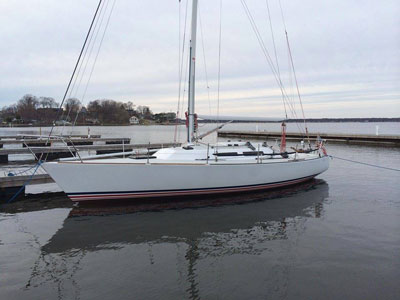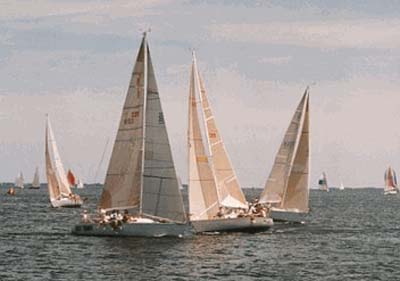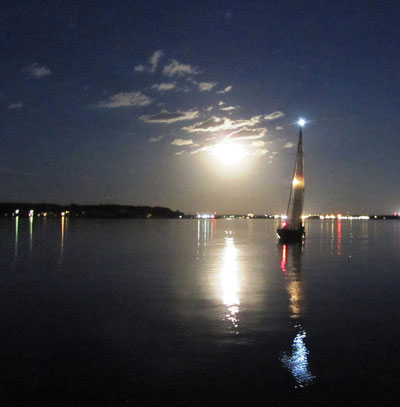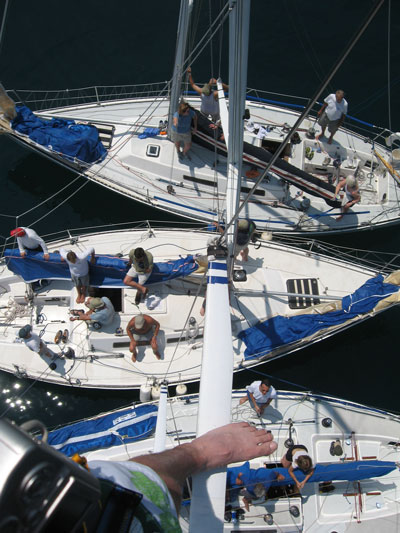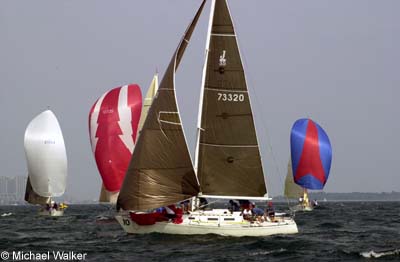
Cutlass Bearing Replacement
Version 1.0 – October 16, 2007
By: Bill Wildner
Introduction
The following is based on my personal experience, there may be better or more correct ways to do this procedure yet this is what has worked for me. Since owning my J35 I removed the Harken bearing, disassembled it, replaced the balls, and reinstalled it. 2 years later I had the same problem only a little worse.
I started to research what bearing to use for replacement and discover 2 options. Option 1 is a bearing that was supplied by Edson this bearing consisted of separate inner and outer races which meant that they had to be glued in place. Option 2 was the Jefa bearing supplied by PYI. This bearing I discovered is nearly identical to the original Harken supplied bearing and is installed in the same manner. Also the Jefa bearing appeared to be very robust, much more so than the original Harken. So I decided on installing the Jefa.
This was one of my winter projects for the boat so after hauling and shoring I embarked on removing the rudder. On my boat the screws that go through the tube to lock the lower bearing in place always worked loose so the lower bearing outer race was a bit loose in the tube. This was helpful in removing the rudder, it comes out pretty straight forward unless the lower bearing is seized in the boat. If you decide to do this job you should also consider replacing the cutlass bearing while the rudder is out of the boat.
Procedure
Removing the rudder:
First thing to do is block up the rudder from under the boat so it does not fall out. Next get on top of the boat and remove the tiller and the rudder post cap that the tiller attaches to. The top bearing will have set screws through the collar locking it to the stainless steel part of the rudder post. Loosen these set screws with a small hex key (allen wrench). The rudder is now ready to drop out of the boat. I usually like to have 2 or 3 people ready to help with this part as the rudder is long and bit heavy and very awkward, once you have handled this a couple of times you could do this with 2 people no problem. You will need enough clearance under the boat to drop the rudder far enough to swing it out and have the other person grab the tube before it comes all the way out of the boat.
If your lower bearing seems to be stuck in the tube you could remove the top bearing completely and try getting some lube down around the bearing. If you need to hammer on the post place a block of wood on the top of the stainless tube and hit the wood with the hammer so as not to damage the stainless tube. If this does not get it moving try having your helper get under the boat and use a pry bar between the hull and the top of the rudder help pull the rudder down while the hammer is used on top. If it doesn’t come out on the first attempt try more penetrating lube and leave it sit over night to work, try again the next day. This should get the rudder moving out of the boat.
Removing the bearing:
The original Harken bearing has set screws holding it to the rudder post. Loosen or remove these screws and try tapping the bearing off the post with a hammer. If the bearing was not glued on it should come off by tapping on alternating sides till it releases completely and you can slide it off.
Examine the bearing area on the post:
On my boat when I removed the bearing the area where the bearing fits on the post had many voids so I needed to build the post up in this area to properly support the bearing, also the new Jefa bearing is a bit taller and required the bearing area to be extended nearly and inch. This is accomplished by using the old Harken bearing as a mold. The rudder will most likely need to be standing straight up for this procedure so find a way to clamp or block the rudder in place standing straight up. Apply a thin coat of petroleum jelly or other grease to the inside diameter of the bearing and slide it on the bearing area about half way. If there are voids that will allow epoxy to run down and out between the bearing and the post get some modeling clay and build a dam all around the bottom of the bearing. Mix some epoxy with filler to that will make it stronger and less prone to cracking and chipping, I use West products, your marine hardware can make recommendations on which filler to use. Once the epoxy is mixed just pour it into the cavity between the bearing and rudder post. If the post is in very bad condition you may need to do this in 2 steps to get the job completed. One thing to be aware of is the inside diameter of the old bearing must be fairly smooth, no deep scratches, pits or voids that will fill with epoxy and make it nearly impossible to remove. Also be careful not to use the area where the set screw holes are as this will also fill with epoxy and make it troublesome to remove.
Once the bearing area is made ready on the rudder post it is time to fit the new bearing. It should be a snug fit but not extremely tight. If you have to pound the bearing on the post this is too tight. What you want is a fit that requires light tapping (with a soft hammer) of the bearing to get it down on the post. When it is right you will know because the amount of pressure to get the bearing down on the post does not increase as the bearing gets further down the shaft. If it is to tight remove the bearing and sand the post down a bit. Once the bearing gets down to location on the post the set screws can be tightened to lock the bearing in place on the post.
Once you get the bearing on the rudder post you are ready to put it back in the boat. In my boat the outside diameter of the bearing did not fit tightly in the tube, after fighting with the set screws that always come loose for a year the following winter I removed the rudder again and installed o-rings in the grooves on the outside diameter of the bearing. After doing this I completely eliminated the lock screws that are inside the boat going through the tube, didn’tneed them to stop the bearing from slopping around in the tube. Depending on the fit in your tube you may try one of these 3 o-rings -265, -262, or -258. You should check the fit of the bearing (without O-rings) in the tube before installing it on the rudder. In my boat I removed the screws and filled the holes with epoxy.
When putting the rudder back in the boat the process is the reverse of the removal. It will be helpful to have 3 people although 2 can do it. Grease the tube where the bearing goes in and put some grease on the o-rings if you use them. It should take a fair bit of force to get the orings to slide up into the tube, this is what you are looking for. The correct amount of force would be such the one fairly strong person could force the bearing in place, or 2 people with firm pressure. After you get the rudder up in the boat reinstall the rudder cap as this will prevent the rudder from sliding down and out of the boat. Turn the rudder from lock to lock to see that all fits properly and moves freely. Tighten the set screws on the upper bearing and again turn from lock to lock checking that rudder moves freely. Person on underside of boat should be seeing that the rudder does not make contact with the hull before coming to its stop. If all is well complete the assembly and enjoy having a tight, free moving rudder.


